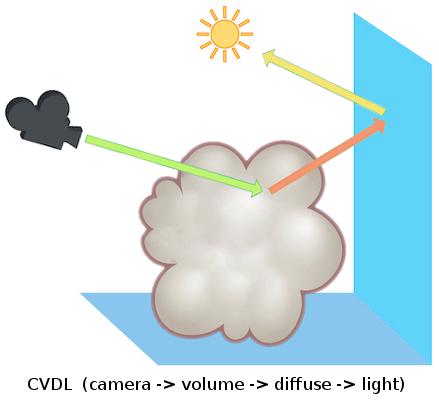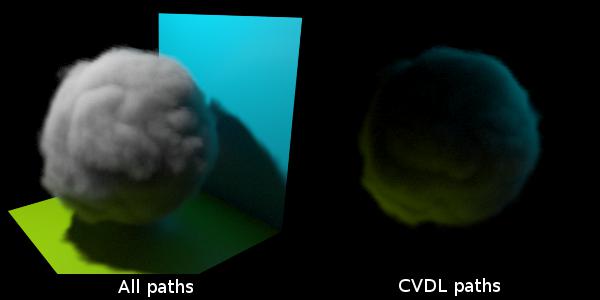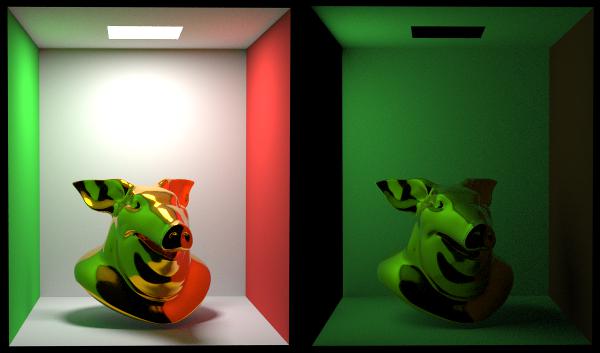| On this page |
Overview ¶
The renderer traces light paths backwards from the camera to the light source. The light path is a series of “scattering events” each time the path interacts with the scene. For example, the light might take a path from the camera (C) where it interacts with a volume (V), a diffuse shaded surface (D), and then reaches a light (L).

A light path expression (LPE) is a type of regular expression that describes a specific light path (or set of paths) based on the scattering events. The expression can be used to “select” the contributions of those kinds of paths to the output. You can use this to isolate very specific parts of the output when compositing, without having to write a custom shader or render that part as a separate pass.

Mantra’s implementation of light path expressions is based on the version in Open Shading Language and shares many of its features and interface.
For more information, you can read the OSL light path expression documentation. However, you should note the differences in Mantra’s implementation.
LPE language ¶
Event types ¶
The following letters match an event of the given type, or any scattering type or custom tag (see below). If you want to exclude those from a match, use <> angle brackets (see wildcards below).
|
Camera |
|
Surface Reflection |
|
Surface Transmission |
|
Volume |
|
Light |
|
Emissive Object |
|
Background (only supported in Karma and not in Mantra) |
|
Albedo (only supported in Karma and not in Mantra) |
Scattering types ¶
|
Diffuse scatter |
|
Glossy scatter |
Wildcards ¶
|
Matches any event. |
|
Matches zero or more of the preceding event. For example, You can combine this with |
|
Matches one or more of the preceding event. For example, As with |
Custom tags ¶
Grouping ¶
|
Matches all the event types inside the angle brackets. For example, |
|
Matches any of the event types inside the square brackets. For example, |
|
Inserting a circumflex ( |
Fully described event ¶
<event_typescatter_type['tag'['bsdf_label']]>
When you use C to match a camera interaction, or D to match a diffuse scattering interaction, this is actually a shorthand for a fully described event, which specifies the event type and optionally the scattering type, and optionally a tag.
For example, R alone matches any reflection off a surface (diffuse or glossy). D alone matches any diffuse scattering event (no matter with what type of object/surface). <RD> only matches a diffuse reflection off a surface.
So, CRL describes direct lighting that includes any type of reflection (diffuse or glossy). CGL describes direct lighting that includes any glossy components (reflection or refraction). If you only want to match direct lighting that is both reflection and glossy, then you would use C<RG>L.
You can include an optional custom tag in the full event description. The interacting object must have the specified tag. For example, <C.'fill'> only matches interactions with a camera with the tag fill. <RD'wall'> only matches diffuse surface reflections off an object tagged wall.
BSDF label is an optional description that follows custom tag. This can be used to separate contributions from BSDFs that fall under the same broad event category, but have different labels. It’s important to note that BSDF label cannot be used in shorthand form. For example, C<...'coat'>L is acceptable. C'coat'L is not.
Using a light path expression ¶
| To... | Do this |
|---|---|
|
Isolate contributions matching an LPE in an image plane |
Note Unshadowed lighting contributions can be expressed by prefixing the expression with Note Light Path Expression AOVs will only accumulate direct lighting contributions from BSDF whose label is listed under Export Components (vm_exportcomponents) in Mantra ROP. If you are using any custom BSDFs with non-predefined labels, please make sure to add them to this list. |
Custom alpha plane ¶
Background event B is used to write out the amount of ray contribution that escapes to the background (i.e. hits nothing), which can be used to represent alpha. You can prepend exclamation mark (!) in front of the expression to negate the output, for a typical alpha where where the background value is zero and foreground elements are non-zero.
For example, lpe:!CB
Examples ¶
Beauty |
|
Indirect diffuse |
|
Direct and indirect bounces from BSDF labelled 'coat' |
|
Direct subsurface scatter from BSDF labelled 'sss' |
|
Emission and visible area lights: |
|
All contribution from light(s) tagged “apple” |
|
Unshadowed direct diffuse |
|
Diffuse and volume albedo |
|
Comparison to OSL ¶
You can see more detailed explanations and examples in the OSL light path expression documentation.
In comparison to the OSL implementation, Mantra does not support the following:
-
No
B(background) event type. -
No
S(singular) ors(straight) scatter type. All specular scatter types are defined asG(glossy) in mantra.
In addition:
-
Mantra uses two different forms of custom labels: LPE Tag that can be assigned to lights and objects, and BSDF label (which is equivalent to OSL’s closure label).
Limitations ¶
-
Mantra’s beauty plane uses full opacity filtering on emission (
Ce) for camera rays, but an LPE expression with visible emission (e.g."lpe:CO") will use screendoor filtering, potentially leading to differing noise quality if the emissive material is partially opaque. -
If an indirect bounce ray hits partially opaque emissive material, you can’t separate its contribution using a custom label (e.g. If an object with emissive material has LPE tag
foo, using an expression such as"lpe:CR<O.'foo'>"is fine if the material is fully opaque, but may lead to unexpected results if the material is not fully opaque). -
PBR Diffuse contributions under the “Translucent” model will be categorized as reflection, not transmission.
